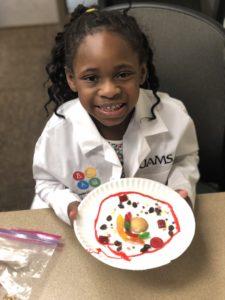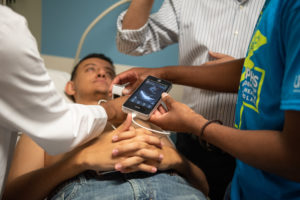Summer Outreach Programs Steer Students to Health Sciences
| There is no lack of learning during the summer, or so goes the thinking at the UAMS Center for Diversity Affairs, which hosted a continuum of programs during the out-of-school months for students from kindergarten to high school, all intended to spark an interest in health sciences.
Two programs in particular, the Junior STEM Academy and the Academy of Pre Health Scholars, provided activities and learning for kindergarten through sixth graders and high school students from freshmen to seniors, respectively.
“These programs are about engaging students at every level to make sure we have a steady pipeline of students interested in sciences, and particularly health sciences, whether they choose to become physicians, nurses, pharmacists, researchers, technicians, paramedics or any other health profession that improves the health of Arkansans and beyond,” said Brian Gittens, Ed.D., UAMS vice chancellor for diversity, equity and inclusion. “What’s important is they come from every walk of life, of every race or ethnicity, to tackle health problems from a perspective of diversity.”
With the Junior STEM Academy, which in its third year hosted the largest class yet at 150 students, that meant grabbing students’ attention early, said program director Amber Booth-McCoy.
“Junior STEM is an exposure program for kids who may not even know they like STEM yet,” she said, using the common acronym for science, technology, engineering and mathematics. “The goal is to pique their interest and hopefully prepare them to stay in the educational pipeline.”
The theme for this year’s program was the Magic STEM Bus, which leaned in to the old PBS TV series Magic School Bus.
“We went inside the body, and we got to study lots of stuff,” said Booth-McCoy.
That included using candy to identify the parts of a cell for younger students and using marbles to show how blood flows through heart valves for older students.
“I try to make it very engaging,” said Katina White, a Project Lead the Way instructor and robotics coach at Forrest Heights STEM Academy, who serves as curriculum manager. “As a STEM person, that’s how I think when designing a lesson or curriculum. I always take a problem-solving approach. So, for the students, we want to teach them a concept first, then once they’ve learned those concepts, we have them solve an engineering problem.”
For instance, she said, older students used a rap video to learn the names for bones, then were challenged to remember them and how they worked as they designed a leg prosthesis.
“The cool thing about this program is that it’s very holistic. Yes, it’s science focused, but we also focus on mental health and wellness; we learn about everything from yoga to meditation to cyber bullying, emotional intelligence, all of that,” said Booth-McCoy.
The result has been high marks from participants and their parents. In evaluations, the program this year received a 100% positive referral rating.
“A lot of our students are willing to look at health profession after this, but I think the big thing is that they’re excited they had fun at school,” said Booth-McCoy. “The biggest thing, the one I love the most, is hearing parents say how their child tackled health science concepts the next year. They’ve learned that science doesn’t have to be scary.”
For older students, the Academy of Pre Health Scholars offers a deep dive into preparation for a career in health care in the years before college decisions are made. Hosting 23 students in its fourth year, the scholars program is an evolution of a decades-old program called Bridging the Gap.
“This program has a culture of excellence. Scholars are expected to succeed,” said Nick Pettus, program director. “We also expect our scholars to give us their best effort and be the best person they can be. And when you set an atmosphere that is conducive, students thrive. When you establish a culture of excellence, scholars see where you’re going and -try to beat you there.”
The program is structured to provide a four-week course of classroom instruction, with some planned excursions, followed by a two-week immersion into learning about health professions. This year’s academy was designed to teach about emergency preparedness and first responder skills.
“Last year our program focused on treating trauma and life in the ER, and in looking at the evaluations from students, they said they wanted to know what happens before health professionals start treating trauma in the ER,” said Pettus of arriving at the focus on first responders.
The emergency preparedness element proved well timed, as students ended up learning about disaster readiness right on the heels of massive flooding throughout the Arkansas River Valley in the spring. They also heard from UAMS Emergency Preparedness about emergency codes and procedures and how the campus plans for disasters like tornadoes..
“ We used the flood as a teaching point for the Emergency Preparedness component,” said Pettus. “We had students work through their own emergency preparedness plan. In addition, students worked with the Hensley Volunteer Fire Department to participate as first responders in a staged six-car accident. They were also challenged to learn triage techniques to treat injuries and were surprised by a simulated emergency scenario in which they were asked to help a mother with a child who couldn’t breathe.
“They spent days going through CPR ,First Aid and Stop the Bleed training, and we had counselors there to walk them through it,” said Pettus. “But you could see in their responses, this is how it is in the life of an emergency responder.”

A second-year medical student explains a model of the heart to participants in the Academy of Pre Health Scholars.
For that reason, part of the instruction also focused on mental health and wellness and the importance of using mental health resources and talking about how incidents can leave an emotional impact.
Students also learned about nutrition and the importance of fitness, particularly in the emergency services fields. They were given a talk about healthy food options and social determinants of health. students were challenged to design solutions to help residents who live in food desserts where cheap food of low nutrition value is plentiful and high nutrition, often more expensive food is not. They learned metabolic processes and why certain food is healthy by studying cardiovascular systems and diseases.
“We reached out to UAMS Nutrition Services and had the opportunity to dive into culinary medicine,” said Pettus. “The plan is to provide skills and learning that students can use immediately in their high schools and their communities, but also to seed an interest in health sciences that will pave the way to the future.”



